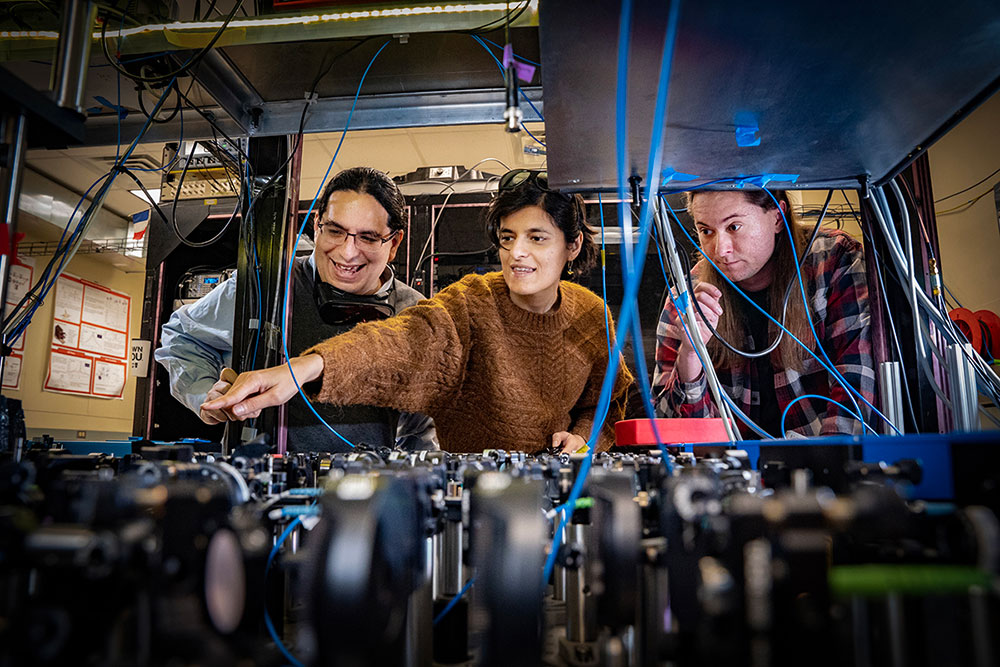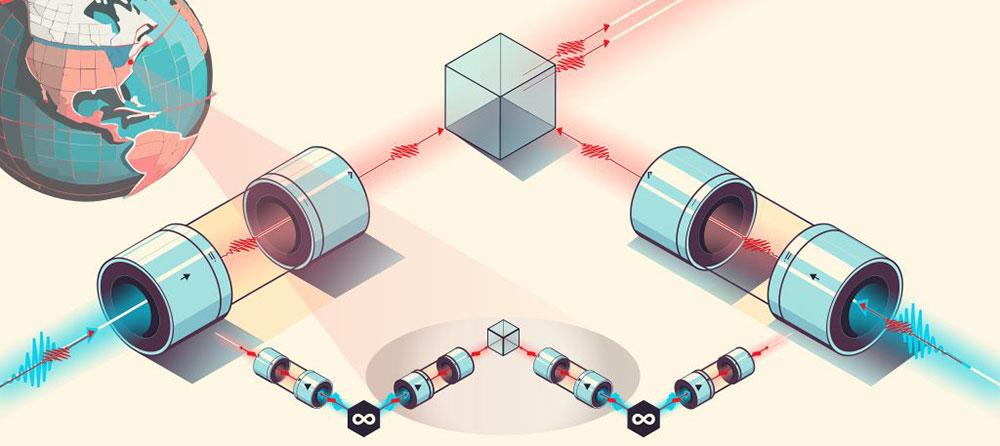SBU Research Team Takes Major Step Toward a Functioning Quantum Internet
February 7, 2024
 enlarge
enlarge
In his Stony Brook Quantum Information Laboratory, lead researcher Eden Figueroa (left) with his collaborators in research investigating quantum internet capacities, Sonali Gera and Chase Wallace. They hope to be on the path to making a quantum internet a reality. Photo by John Griffin.
Editor's note: The following news release was originally issued by Stony Brook University. Lead researcher Eden Figueroa is a joint appointee at Brookhaven National Laboratory. At Brookhaven, Figueroa helped develop a Quantum Network Facility that will serve scientists from across the country and around the world who are working to advance the exciting new field of quantum networks for communication, computing, and sensing. For more information on Brookhaven’s involvement, contact Pete Genzer, genzer@bnl.gov.
A team of Stony Brook University physicists and their collaborators have taken a significant step toward the building of a quantum internet testbed by demonstrating a foundational quantum network measurement that employs room-temperature quantum memories. Their findings are described in a paper published in the Nature journal Quantum Information.
Research with quantum computing and quantum networks is taking place around the world in the hopes of developing a quantum internet, a network of quantum computers, sensors, and communication devices that will create, process, and transmit quantum states and entanglement. It is anticipated to enhance society’s internet system and provide certain services and securities that the current internet does not have.
The field of quantum information combines aspects of physics, mathematics, and classical computing to use quantum mechanics to solve complex problems much faster than classical computing and to transmit information in an unhackable manner. While the vision of a quantum internet system is growing and the field has seen a surge in interest from researchers and the public at large, accompanied by a steep increase in the capital invested, an actual quantum internet prototype has not been built.
According to the Stony Brook research team, the key hurdle to achieve the potential of making communication networks more secure, measurement systems more precise, and algorithms for certain scientific analyses more powerful, relies on developing systems capable of bringing quantum information and entanglement across many nodes and over long distances. These systems are called quantum repeaters and are one of the more complex challenges in current physics research.
The researchers have advanced quantum repeater capacities in their latest experimentation. They built and characterized quantum memories that operate at room temperature and demonstrated that these memories have identical performance, an essential feature when the goal is to build large-scale quantum repeater networks that will comprise several of these memories.
They tested how identical these memories are in their functionality by sending identical quantum states into each of the memories and performing a process called Hong-Ou-Mandel Interference on the outputs from the memories, a standard test to quantify the indistinguishability of photon properties. They demonstrated that the process of storing and retrieving optical qubits in their room-temperature quantum memories does not significantly distort the joint interference process and allows for memory-assisted entanglement swapping, a protocol to distribute entanglement over long distances and the key to building operational quantum repeaters.
“We believe this is an extraordinary step toward the development of viable quantum repeaters and the quantum internet,” said lead author Eden Figueroa, Stony Brook Presidential Innovation Endowed Professor and Director of the Center for Distributed Quantum Processing, who holds a joint appointment at the U.S. Department of Energy’s Brookhaven National Laboratory.
The quantum hardware developed by the team operates at room temperature, significantly bringing down the cost of operation and making the system much faster. Much of quantum research is done at temperatures near absolute zero, which are more expensive, slower and technically more challenging to network. Thus, room-temperature technology is a promising one for building large-scale quantum networks.
The team has received U.S. patents regarding quantum storage at room temperature and high-repetition-rate quantum repeaters.
“To get these fleets of quantum memories to work together at a quantum level, and in a room temperature state, is something that is essential for any quantum internet on any scale. To our knowledge, this feat has not been demonstrated before, and we expect to build on this research,” emphasized Figueroa, noting that their patented technology enables them to further test the quantum network.
Co-authors Sonali Gera, a postdoctoral researcher, and Chase Wallace, a doctoral student, both in the Department of Physics and Astronomy in Stony Brook’s College of Arts and Sciences, worked closely with Figueroa and other colleagues during the experimentation, which aims to effectively “amplify” entanglement over distances, the essential function of a quantum repeater.
“Because the memories are capable of storing photons with a user-defined storage time, we were also able to show time synchronization of the photons’ retrieval despite the photons arriving at the memories at random times, which is another feature necessary to operate a quantum repeater system,” explained Gera.
She and Wallace add that some of the next steps in the team’s research are to build and characterize sources of entanglement compatible with the quantum memories and to design mechanisms to “herald” the presence of stored photons across many quantum memories.
The research was performed in collaboration with scientists from Qunnect, Inc., a Brooklyn, NY-based quantum technology spinoff from Stony Brook University, and with international colleagues from the University of Padova in Italy.
How a Quantum Repeater Network Works
A quantum repeater hop requires two sources of entangled photon pairs separated by distance L (infinite symbols in the image below). One photon from each pair is sent toward a central measurement node (central shaded area in figure), where they are stored in quantum memories. Their partner photons are sent in opposite directions, also stored in quantum memories separated by a distance 2L. A measurement quantifying the indistinguishability of the two photons arriving at the central node, similar to what was demonstrated by Figueroa’s team, can be used to entangle the distantly located photons.
This protocol is equivalent to effectively “amplifying” entanglement as it distributes entanglement over a distance that is twice the distance (2L) that a single source of entangled photons could achieve (L). Stitching together several of these repeater hops, it is possible to spread entanglement over hundreds of kilometers.
2024-21718 | INT/EXT | Newsroom










